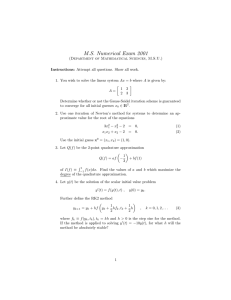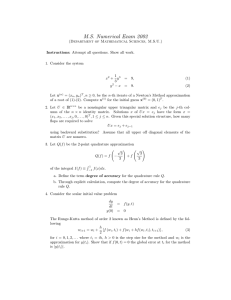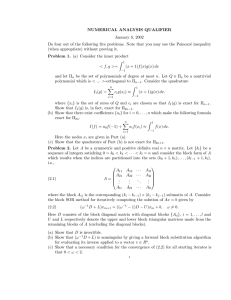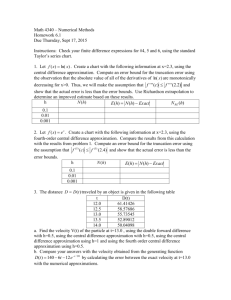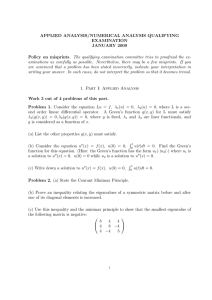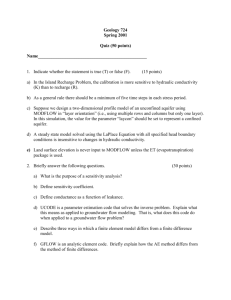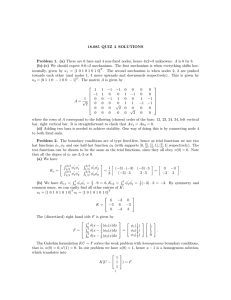NUMERICAL ANALYSIS QUALIFIER Problem 1. May 29, 2002
advertisement
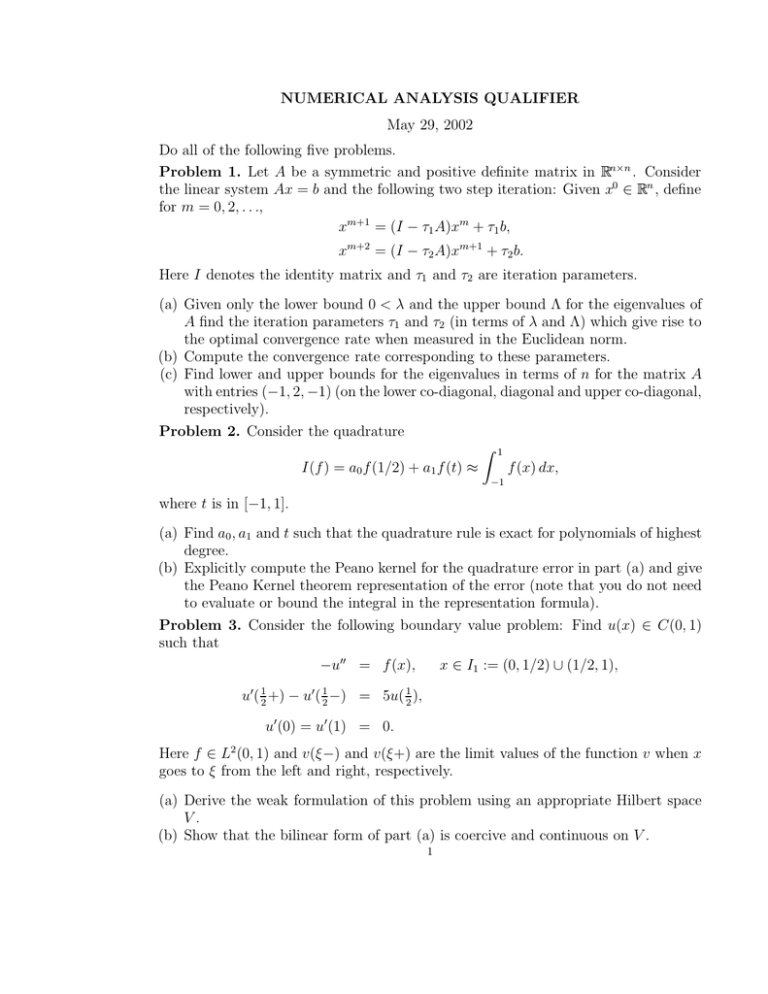
NUMERICAL ANALYSIS QUALIFIER
May 29, 2002
Do all of the following five problems.
Problem 1. Let A be a symmetric and positive definite matrix in Rn×n . Consider
the linear system Ax = b and the following two step iteration: Given x0 ∈ R n , define
for m = 0, 2, . . .,
xm+1 = (I − τ1 A)xm + τ1 b,
xm+2 = (I − τ2 A)xm+1 + τ2 b.
Here I denotes the identity matrix and τ1 and τ2 are iteration parameters.
(a) Given only the lower bound 0 < λ and the upper bound Λ for the eigenvalues of
A find the iteration parameters τ1 and τ2 (in terms of λ and Λ) which give rise to
the optimal convergence rate when measured in the Euclidean norm.
(b) Compute the convergence rate corresponding to these parameters.
(c) Find lower and upper bounds for the eigenvalues in terms of n for the matrix A
with entries (−1, 2, −1) (on the lower co-diagonal, diagonal and upper co-diagonal,
respectively).
Problem 2. Consider the quadrature
Z 1
I(f ) = a0 f (1/2) + a1 f (t) ≈
f (x) dx,
−1
where t is in [−1, 1].
(a) Find a0 , a1 and t such that the quadrature rule is exact for polynomials of highest
degree.
(b) Explicitly compute the Peano kernel for the quadrature error in part (a) and give
the Peano Kernel theorem representation of the error (note that you do not need
to evaluate or bound the integral in the representation formula).
Problem 3. Consider the following boundary value problem: Find u(x) ∈ C(0, 1)
such that
−u00 = f (x),
x ∈ I1 := (0, 1/2) ∪ (1/2, 1),
u0( 12 +) − u0 ( 12 −) = 5u( 12 ),
u0 (0) = u0 (1) = 0.
Here f ∈ L2 (0, 1) and v(ξ−) and v(ξ+) are the limit values of the function v when x
goes to ξ from the left and right, respectively.
(a) Derive the weak formulation of this problem using an appropriate Hilbert space
V.
(b) Show that the bilinear form of part (a) is coercive and continuous on V .
1
2
(c) Consider the finite element method for this problem based on linear finite elements
over a uniform partition of [0, 1] with mesh-size h = 1/m. Show that the Galerkin
approximation is first order accurate in the H 1 -norm if the mesh is aligned with
the point x = 0.5. (You may use the fact that u satisfies the a priori estimate
||u00 ||2L2 (I1 ) + ||u00||2L2 (I2 ) = ||f ||2L2(0,1) .
This follows immediately from the equation. Note, however, that u is generally
not in H 2 (0, 1).)
P
Problem 4. (a) Consider the tensor product space Q2 = { 2i,j=0 ci,j xi y j } and the
the reference square τ̂ ≡ [0, 1]2 with nodes as illustrated below
v1
v5
v2
v8
v9
v6
v4
v7
v3 .
Show that these nodes form a unisolvent set for Q2 .
(b) Let {φi }, i = 1, . . . , 9 be the nodal basis functions associated with the above
nodes. Compute φ4 explicitly.
(c) Consider the reduced space
4
9
X
X
0
p(vi ) − 2
p(vi ) = 0 .
Q2 = p ∈ Q2 : 4p(v9 ) +
i=1
i=5
Show that Q2 contains P2 , the space of polynomials in x and y of total degree at
most 2.
(d) Let Ω be a rectangular domain and Ω = ∪τ̄i be an admissible partitioning of Ω
into smaller rectangular elements. Let Sh be the space of piecewise (with respect
to this partitioning) Q02 functions based on the reference nodes {vi }, i = 1, . . . , 8
(this set of nodes forms a unisolvent set for Q02 ). Show that Sh is contained in
H 1 (Ω)
Problem 5. Consider the parabolic problem
ut − uxx = f, for (x, t) ∈ (0, 1) × (0, T ],
u(0, t) = u(1, t) = 0, for t ∈ (0, T ],
u(x, 0) = u0 (x), for x ∈ [0, 1].
Here f and u0 are given sufficiently smooth functions and T > 0.
(a) Let Sh be a finite element approximation subspace in H01 (Ω) and U 0 ∈ Sh be an
approximation to u0 . For θ in [0, 1] consider the fully discrete scheme: U n ∈ Sh
3
satisfies
U n − U n−1
, φ + D(θU n + (1 − θ)U n−1 , φ) = (f (tn+θ ), φ),
(5.1)
k
for all φ ∈ Sh . Here
Z 1
(v, w) ≡
vw dx,
D(v, w) ≡ (vx , wx ),
0
k is the time step size, tα = αk and U n approximates the solution u(·, tn ). Show
that (5.1) is unconditionally stable when θ is in [1/2, 1].
(b) Define the analogous finite difference method using the 3-point stencil as an approximation to uxx .
(c) Using Fourier mode analysis, derive a CFL condition (depending on θ) for the
finite difference approximation of part (b) which guarantees stability when θ is in
[0, 1/2).
